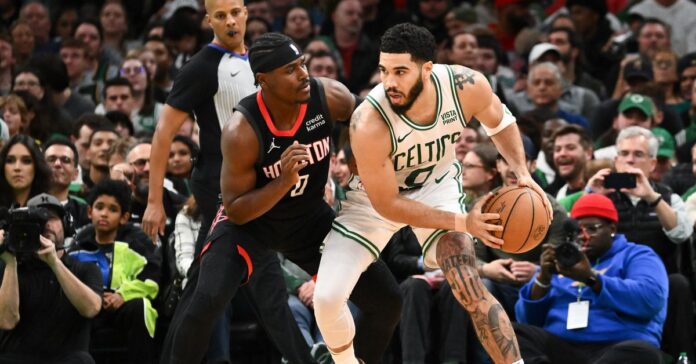As you’ll quickly notice, went with a different format this week.
Oftentimes, perception does not match reality. For instance, my mom thinks I’m a “very handsome boy,” but I’m much closer to an average man, with the jury still being very much out on the “man” part (although I did just replace our faucet), I’m basically Bob Vila).
So too is our perception of NBA players and their skillsets fraught with biases and prejudice. One such bias that I long held related to Jayson Tatum and his ability as an isolation scorer. He makes pretty step-backs and the occasional mid-range jumper, so certainly he’s elite in isolation, right?
Actually, ghost of Spooney’s past, he’s never been elite at isolations. In fact, he’s been average to below average his entire career, and in his second season he was dreadful. For all the skill and all the size, Jayson Tatum has been a pretty lukewarm isolation player, until now.
Here are Tatum’s points per possession numbers (including passes and playoffs) by year (from Synergy):
- 2017-18 – .811
- 2018-19 – .626
- 2019-20 – 1.04
- 2020-21 – .874
- 2021-22 – .963
- 2022-23 – .972
- 2023-24 – 1.21
The (somewhat) linear improvement of a superstar. Through the years, Tatum has slowly gotten bigger, faster, stronger, and more skilled and it’s making unimpeachable dividends this season. Of players that have 100 or more isolations, Tatum is 6th in points per possession this season. Last year he was 30th.
There are a few reasons the isolation game has started to blossom like Washington DC’s aptly named Cherry Blossoms. First, is the strength. I wrote last week that Tatum is getting to his spots and holding them tighter than Stonewall Jackson at the Battle of Bull Run (the traitor). That was in the context of his strength benefitting post-ups because he can get deeper. more favorable positions to post from. The same logic goes for isolations. He often battles for position at the elbow, holds his ground, and then faces up for an iso once the ball arrives.
The upgraded strength also pays dividends at the rim. Here, he does get bumped off the spot by Jamie Jacquez Jr., who is a big wing in his own right, but Tatum dusts him with his first step and then bounces off Jacquez at the rim.
Second, Tatum is doing a much better job punishing switches. He still bails out bigs with the occasional ill-advised step-back, like in this play.
But far more regularly, Tatum is putting the ball on the deck against switched bigs and dusting them with his combo of speed, size, strength, and skill — the 4 S’s as they’re known (or not since I just made that up).
That’s a textbook pirouette, Brook, very graceful. And while he bailed KAT out in the above clip, he certainly made up for it later in his dominant crunch-time performance.
In this one, KAT switches onto Tatum after a Luke Kornet pick and roll. Tatum wisely goes wide, which forces Kyle Anderson to either commit to a double, or track Kornet rolling. He chooses to track Kornet. Tatum sets KAT up with a beautiful little slow spin and then he’s off to the rim.
Here, Tatum is coming off a Horford wide pin-down. Edwards attempts to “fight” (using that word very loosely) over the screen, but the switch is forced and Tatum attacks Naz Reid from the elbow. You know what happens next.
Then this OT beauty where Tatum has KAT switched onto him out high. He backs WAY up so he can get a head of steam. He hits KAT with his patented half spin, gets fouled, and keeps playing through it after the no call (like Stonewall Jackson, the refs are traitors). Then, Tatum drops KAT and the Wolves with a series of dastardly crossovers that left my ankles broken through the screen. Absolutely. Nasty.
The final piece to the elite isolation pie, which does not sound very tasty, is the mid-range jumper. Tatum has, historically, shot the middy pretty poorly, even though it was the foundation of his game in college.
2021-22 – 3.4 FGA – 37.0%
2022-23 – 2.1 FGA – 37.5%
2023-24 – 3.0 FGA – 43.3%
This year is a recent exception. The good news is that the improvement is not so dramatic as to seem unsustainable. It’s a sizeable increase, but it’s not anomalistic.
I don’t get the impression he’s taking better mid-range jumpers than previous seasons. Many of them are fairly well guarded and of the variety where Tatum either fades or rises right over a smaller defender (and sometimes both). It seems like either the sample size is small, and we can expect some regression, or, and as I believe, he’s just flat out gotten better at them.
They aren’t easy shots, but they are the types of shots a player of Tatum’s caliber can make. They’re also extremely easy to generate out of isolation, like the clip above of him shooting over Maxey. There’s not a lot of offensive creativity required on some of these.
And therein lies the problem. Tatum can isolate literally every time he touches the ball – if he wants to. It is the most basic play in basketball, glorified 1-on-1. Because he’s been so good at them, there’s a temptation to grind the offense to a halt, give it to Tatum, and watch him go to work.
But that is a losing strategy, and so far, the Celtics and Tatum have mostly resisted that temptation. In fact, it’s because they are not deploying his isolations in that manner that he’s improved. Instead, the Celtics are opting for Tatum to come off screens before attacking, or to generate favorable matchups by forcing switches. If they can continue to resist the temptation, keep the offense flowing, and go to Tatum when he’s got a favorable matchup, there’s no reason Tatum can’t stay elite.






















